
Scorpions are predatory arachnids of the order Scorpiones. They have eight legs, and are easily recognized by a pair of grasping pincers and a narrow, segmented tail, often carried in a characteristic forward curve over the back and always ending with a stinger. The evolutionary history of scorpions goes back 435 million years. They mainly live in deserts but have adapted to a wide range of environmental conditions, and can be found on all continents except Antarctica. There are over 2,500 described species, with 22 extant (living) families recognized to date. Their taxonomy is being revised to account for 21st-century genomic studies.
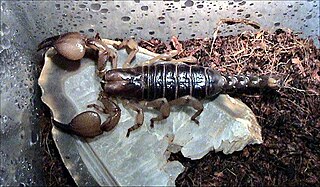
Opistophthalmus is a genus of scorpions known commonly as burrowing scorpions, tricolored scorpions, serkets, or hissing scorpions. They are found predominantly in southern Africa. They are known for making deep and elaborate burrows.
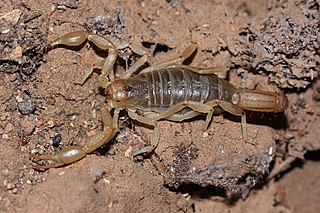
Paravaejovis spinigerus, commonly known as the stripe-tailed scorpion or devil scorpion, is a species of scorpion in the family Vaejovidae. It is found in the south-western United States and north-western Mexico. Tultepec México

The Buthidae are the largest family of scorpions, containing about 100 genera and 1339 species as of 2022. A few very large genera are known, but a high number of species-poor or monotypic ones also exist. New taxa are being described at a rate of several new species per year. They have a cosmopolitan distribution throughout tropical and subtropical environments worldwide. Together with four other families, the Buthidae make up the superfamily Buthoidea. The family was established by Carl Ludwig Koch in 1837.

Centruroides is a genus of scorpions of the family Buthidae. Several North American species are known by the common vernacular name bark scorpion. Numerous species are extensively found throughout the southern United States, Mexico, Central America, the Antilles and northern South America. Some are known for their interesting patterning or large size ; most if not all fluoresce strongly under ultraviolet illumination, except after moulting. They contain several highly venomous species, and fatalities are known to occur. The venom of the Mexican scorpion Centruroides limpidus limpidus contains the neurotoxins Cll1 and Cll2.
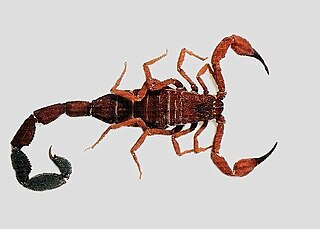
Tityus is a large genus of thick-tailed scorpions, the namesake of its subfamily Tityinae. As of 2021, Tityus contains more than 220 described species distributed in Central America and South America, from Costa Rica to Argentina. Species in the genus Tityus have been studied for hundreds of years, long before the taxonomic classification was put in place. Tityus tend to be of medium size for scorpions, roughly 50 to 70 millimeters long. They are dark brown or red in color, and can exhibit sexual dimorphism. They can live in a variety of environments, ranging from urban to arid mountains to the Amazon Rainforest. Tityus scorpions are best known for their venom and potent sting. The genus contains several dangerously venomous scorpions, the best known of which is the Brazilian yellow scorpion, T. serrulatus. Its venom can cause severe illness, and in the young, old and infirm even death. Some experts have argued that the genus as a whole may be paraphyletic, which could explain the knowledge gaps related to Tityus.

Hubbardiidae is a family of arachnids, superficially resembling spiders. It is the larger of the two extant families of the order, Schizomida, and is divided into two subfamilies. The family is based on the description published by Orator F. Cook in 1899. The American Arachnological Society assigns the common name hubbardiid shorttailed whipscorpion to members of this family.
The taxonomy of scorpions deals with the classification of this predatory arthropod into 13 extant families and about 1,400 described species and subspecies. In addition, 111 described taxa of extinct scorpions are known.

Vaejovidae is a family of scorpions, comprising 25 genera and 227 species, found in North America. The species of the genus are found in Mexico and the southern United States, and Paruroctonus boreus is found in Canada and is the northernmost species of scorpion in the world.
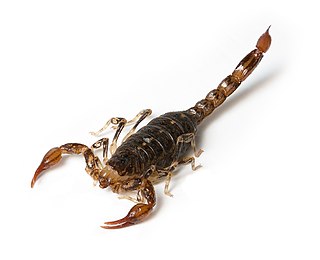
The Bothriuridae are a family of scorpions, comprising 151 species in 16 genera.

Nebo is a genus of scorpions in the family Diplocentridae.

Urodacus is a genus of scorpion belonging to the family Urodacidae. It was described by German naturalist Wilhelm Peters in 1861. The type species is U. novaehollandiae. Its species are native to Australia, and dig burrows. The genus was placed in its own family in 2000. Before this, the group had been a subfamily Urodacinae within the family Scorpionidae.

Opisthacanthus is a genus of scorpions in the family Hormuridae occurring in Central and South America, the Caribbean, Africa and Madagascar.

Nebo flavipes is a species of scorpions in the family Diplocentridae endemic to Yemen. .

Scorpiops is a genus of scorpions in the family Scorpiopidae. It is distributed throughout much of Asia. The taxonomy of the group is unclear because new species and subgenera are described often, and one subgroup may represent a species complex.

Hormurus is a genus of scorpions, commonly known as rainforest scorpions, in the family Hormuridae, that occur in rainforest habitats, mainly in Australia and Melanesia. The genus was first described by Swedish arachnologist Tamerlan Thorell in 1876.
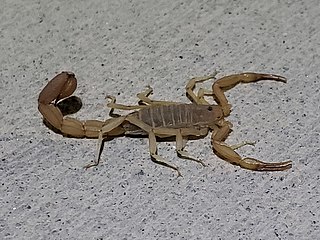
Paravaejovis is a genus of scorpions in the family Vaejovidae. There are about 11 described species in the genus Paravaejovis.
Kolotl is a genus of scorpions in the family Diplocentridae, native to Mexico. Named for the Nahuatl word for scorpion, they can be almost 10 cm long.

Diplocentrus is a genus of toothed scorpions in the family Diplocentridae. There are more than 60 described species in Diplocentrus, found mainly in Central America, Mexico, and the southwest United States.

Cercophonius is a genus of six species of Australian scorpions, often termed wood scorpions, in the family Bothriuridae.

















